-
 Colour (tone) lithography, image 396 x 508 mm, sheet 532 x 654 mm; before signature, undated; pencil ms inscription: Föhrenhain — E. Pelikan / 200M to the lower-right corner of the sheet. Contributor: Emilie Mediz-Pelikan (Austrian, 1861 – 1908) – artist. Seller's description: Austrian-German painter and graphic artist. Emilie Mediz-Pelikan was born in Vöcklabruck in 1861. She studied at the Vienna Academy and followed her teacher Albert Zimmermann to Salzburg and in 1885 to Munich. In 1891 she married the painter and graphic artist Karl Mediz (1868 - 1945), with whom she lived in Vienna and from 1894 in Dresden. She was in contact with the Dachau Artists' Colony and went on study trips to Paris, Belgium, Hungary and Italy. In the Dachau artists' colony she was friends with Adolf Hölzel and Fritz von Uhde. In 1889 and 1890 she spent time in Paris and in the Belgian artists' colony Knokke. In 1898 she was represented at the first art exhibition of the Vienna Secession, and in 1901 at the International Art Exhibition in Dresden. In 1903 she and her husband had a group exhibition, at the Hagenbund in Vienna. In 1904, she showed graphic works at the Dresden royal court art dealer Richter, and in 1905 and 1906 she exhibited at the Berlin Künstlerhaus. It was not until around 1900 that she achieved her artistic breakthrough with her landscape paintings. Since the estate of the artist, who died prematurely in Dresden in 1908, was lost in the former GDR until the 1980s, it was quite late that the artist was rediscovered and revalued both in Austrian art history and on the art market. In 1986, the first major exhibitions took place at the Upper Austrian State Museum and the University of Applied Arts in Vienna, followed by numerous smaller exhibitions in private galleries in Vienna, Linz and Munich. The artist received recognition during her lifetime from numerous prominent fellow painters as well as from the art critic Ludwig Hevesi. Together with Tina Blau, Herbert Boeckl, Marie Egner, Theodor von Hörmann, Franz Jaschke, Eugen Jettel, Ludwig Heinrich Jungnickel, Rudolf Junk, Gustav Klimt, Oskar Kokoschka, Johann Victor Krämer, Heinrich Kühn, Carl Moll, Rudolf Quittner, Rudolf Ribarz, Emil Jakob Schindler, Max Suppantschitsch, Max Weiler, Olga Wisinger-Florian and Alfred Zoff, she was a protagonist of the reception of Impressionism in Austria. This style went down in Austrian art history under the term "Stimmungsimpressionismus".
Colour (tone) lithography, image 396 x 508 mm, sheet 532 x 654 mm; before signature, undated; pencil ms inscription: Föhrenhain — E. Pelikan / 200M to the lower-right corner of the sheet. Contributor: Emilie Mediz-Pelikan (Austrian, 1861 – 1908) – artist. Seller's description: Austrian-German painter and graphic artist. Emilie Mediz-Pelikan was born in Vöcklabruck in 1861. She studied at the Vienna Academy and followed her teacher Albert Zimmermann to Salzburg and in 1885 to Munich. In 1891 she married the painter and graphic artist Karl Mediz (1868 - 1945), with whom she lived in Vienna and from 1894 in Dresden. She was in contact with the Dachau Artists' Colony and went on study trips to Paris, Belgium, Hungary and Italy. In the Dachau artists' colony she was friends with Adolf Hölzel and Fritz von Uhde. In 1889 and 1890 she spent time in Paris and in the Belgian artists' colony Knokke. In 1898 she was represented at the first art exhibition of the Vienna Secession, and in 1901 at the International Art Exhibition in Dresden. In 1903 she and her husband had a group exhibition, at the Hagenbund in Vienna. In 1904, she showed graphic works at the Dresden royal court art dealer Richter, and in 1905 and 1906 she exhibited at the Berlin Künstlerhaus. It was not until around 1900 that she achieved her artistic breakthrough with her landscape paintings. Since the estate of the artist, who died prematurely in Dresden in 1908, was lost in the former GDR until the 1980s, it was quite late that the artist was rediscovered and revalued both in Austrian art history and on the art market. In 1986, the first major exhibitions took place at the Upper Austrian State Museum and the University of Applied Arts in Vienna, followed by numerous smaller exhibitions in private galleries in Vienna, Linz and Munich. The artist received recognition during her lifetime from numerous prominent fellow painters as well as from the art critic Ludwig Hevesi. Together with Tina Blau, Herbert Boeckl, Marie Egner, Theodor von Hörmann, Franz Jaschke, Eugen Jettel, Ludwig Heinrich Jungnickel, Rudolf Junk, Gustav Klimt, Oskar Kokoschka, Johann Victor Krämer, Heinrich Kühn, Carl Moll, Rudolf Quittner, Rudolf Ribarz, Emil Jakob Schindler, Max Suppantschitsch, Max Weiler, Olga Wisinger-Florian and Alfred Zoff, she was a protagonist of the reception of Impressionism in Austria. This style went down in Austrian art history under the term "Stimmungsimpressionismus". -
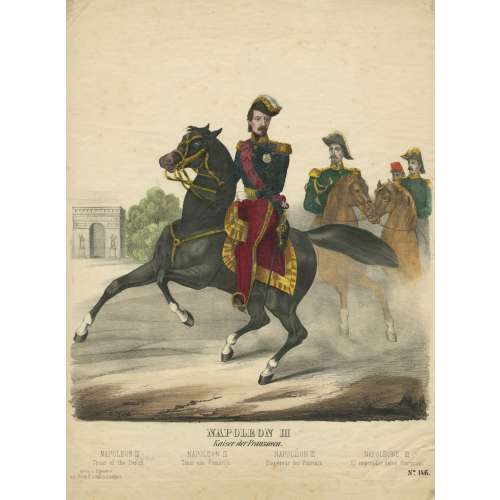 Hand-coloured lithography on wove paper 423 x 332 mm; On reverse: black ink stamp “4956”, ms “A”, ms pencil “428” and “Ernest”. Under the image, centre: "NAPOLEON III | Kaiser der Franzosen." Velow: | NAPOLEON III | Czaar of the French — NAPOLEON III | Czaar van Frankrijk — NAPOLÉON III | Empereur des Francais. — NAPOLEONE III | El emperador delos Franceses; bottom left: "Verlag u. Eigenthum | von. Fried. G. Schulz in Stuttgart.", right: "No 146." The artist's and printer's names in stone are not legible. Published in Stuttgart by Friederich Gustav Schulz (German, 1786 – 1859) during the time of the Second French Empire (1852-1870).
Hand-coloured lithography on wove paper 423 x 332 mm; On reverse: black ink stamp “4956”, ms “A”, ms pencil “428” and “Ernest”. Under the image, centre: "NAPOLEON III | Kaiser der Franzosen." Velow: | NAPOLEON III | Czaar of the French — NAPOLEON III | Czaar van Frankrijk — NAPOLÉON III | Empereur des Francais. — NAPOLEONE III | El emperador delos Franceses; bottom left: "Verlag u. Eigenthum | von. Fried. G. Schulz in Stuttgart.", right: "No 146." The artist's and printer's names in stone are not legible. Published in Stuttgart by Friederich Gustav Schulz (German, 1786 – 1859) during the time of the Second French Empire (1852-1870). -
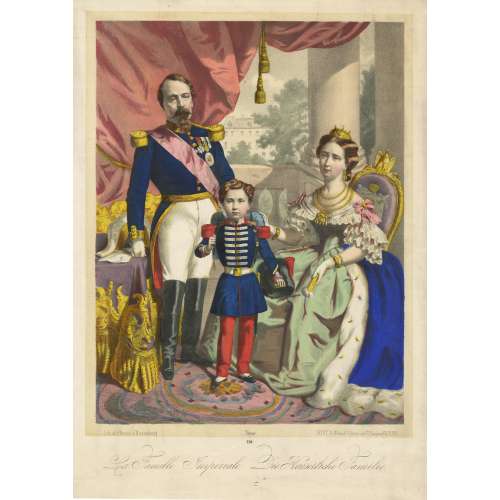 Hand-coloured lithography on wove paper, 395 x 280 mm; black ink stamp “5309” to reverse. On image: artist's initials "L. H."; on stone: "Lith. de Fr. Wentzel a Wissembourg. — Déposé — DÉPÔT, Fr. Wentzel Editeur rue St. Jacques 65, PARIS"; below centre: "239"; bottom : La famille Impériale. Die Kaizerliche Familie. Napoleon III [Charles-Louis Napoléon Bonaparte] (French, 1808 – 1873) Eugénie de Montijo [L'impératrice Eugénie] (Spanish-French, 1826 – 1920) Napoléon, Prince Imperial (Napoléon Eugène Louis Jean Joseph Bonaparte] (French, 1856 – 1879) Jean Frédéric Wentzel (French, 1807 – 1869) – publisher/printer.
Hand-coloured lithography on wove paper, 395 x 280 mm; black ink stamp “5309” to reverse. On image: artist's initials "L. H."; on stone: "Lith. de Fr. Wentzel a Wissembourg. — Déposé — DÉPÔT, Fr. Wentzel Editeur rue St. Jacques 65, PARIS"; below centre: "239"; bottom : La famille Impériale. Die Kaizerliche Familie. Napoleon III [Charles-Louis Napoléon Bonaparte] (French, 1808 – 1873) Eugénie de Montijo [L'impératrice Eugénie] (Spanish-French, 1826 – 1920) Napoléon, Prince Imperial (Napoléon Eugène Louis Jean Joseph Bonaparte] (French, 1856 – 1879) Jean Frédéric Wentzel (French, 1807 – 1869) – publisher/printer. -
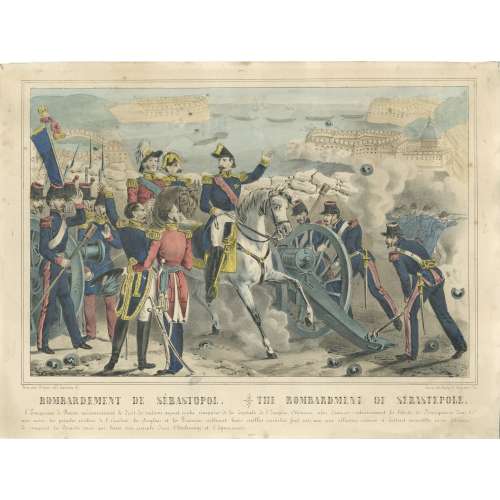 Hand-coloured lithography on wove paper, 250 x 332 mm; black ink stamp “5035” to reverse. Under the frame left: "Paris, chez Riboni, éd. r. Galande, 51"; right: "Paris, lith. Bulla, Pl. Maubert, 26". Below: "BOMBARDEMENT DE SEBASTOPOL. — THE BOMBARDMENT OF SÉBASTOPOLE". Text to bottom. Printers/publishers: Antoine Bulla (fl. 1815 – 1877), François Bulla (fl. c. 1814 – 1855).
Hand-coloured lithography on wove paper, 250 x 332 mm; black ink stamp “5035” to reverse. Under the frame left: "Paris, chez Riboni, éd. r. Galande, 51"; right: "Paris, lith. Bulla, Pl. Maubert, 26". Below: "BOMBARDEMENT DE SEBASTOPOL. — THE BOMBARDMENT OF SÉBASTOPOLE". Text to bottom. Printers/publishers: Antoine Bulla (fl. 1815 – 1877), François Bulla (fl. c. 1814 – 1855). -
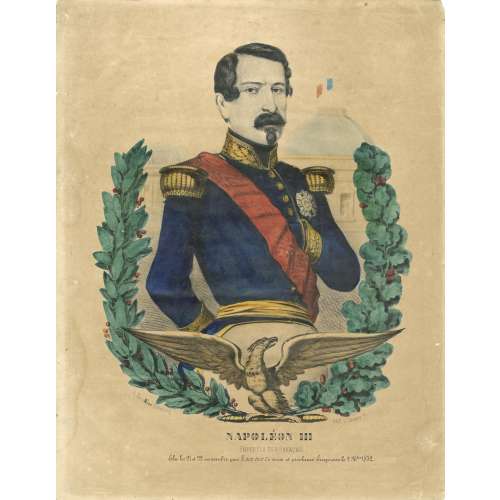 Hand-coloured lithography on wove paper, 380 x 298 mm; black ink stamp “4912” to reverse. On stone left: "A, Paris Miné Éditeur, imp.;" right: "Lith. R. St. Jacques. 41." Bottom center: "Napoléon III"; below: "EMPEREUR DES FRANÇAIS", under: "Élu les 21 el 22 novembre par 8,000,000 de voix et proclamé Empereur le 2 Xbre 1852." Printer/publisher: Miné, éditeur, imprimeur en lithographie, Rue Saint-Jacques, 41. Napoleon III [Charles-Louis Napoléon Bonaparte] (French, 1808 – 1873)
Hand-coloured lithography on wove paper, 380 x 298 mm; black ink stamp “4912” to reverse. On stone left: "A, Paris Miné Éditeur, imp.;" right: "Lith. R. St. Jacques. 41." Bottom center: "Napoléon III"; below: "EMPEREUR DES FRANÇAIS", under: "Élu les 21 el 22 novembre par 8,000,000 de voix et proclamé Empereur le 2 Xbre 1852." Printer/publisher: Miné, éditeur, imprimeur en lithographie, Rue Saint-Jacques, 41. Napoleon III [Charles-Louis Napoléon Bonaparte] (French, 1808 – 1873) -
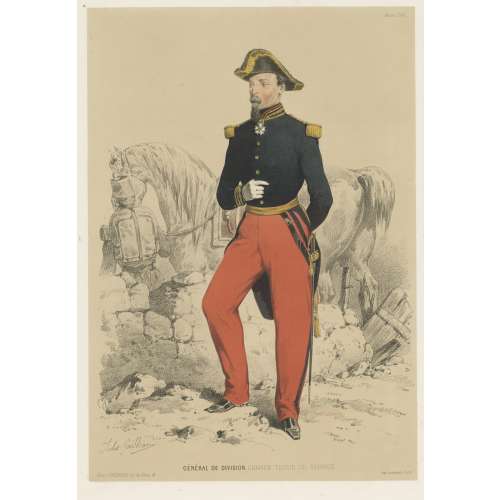 Chromolithography on thick wove paper, 473 x 315 mm sheet, 372 x 260 mm image, black ink stamp “5050” to reverse. Signed on stone "Jules Gaildrau"; below centre: "GÉNERAL DE DIVISION, GRANDE TENUE DE SERVICE"; Bottom left: "Paris, J. Gaildrau, rue de Seine, 16"; right: "Imp. Lemercier, Paris." Joseph Lemercier (French, 1803 – 1887) – printer. Jules Gaildrau (French, 1816 – 1898) – artist.
Chromolithography on thick wove paper, 473 x 315 mm sheet, 372 x 260 mm image, black ink stamp “5050” to reverse. Signed on stone "Jules Gaildrau"; below centre: "GÉNERAL DE DIVISION, GRANDE TENUE DE SERVICE"; Bottom left: "Paris, J. Gaildrau, rue de Seine, 16"; right: "Imp. Lemercier, Paris." Joseph Lemercier (French, 1803 – 1887) – printer. Jules Gaildrau (French, 1816 – 1898) – artist. -
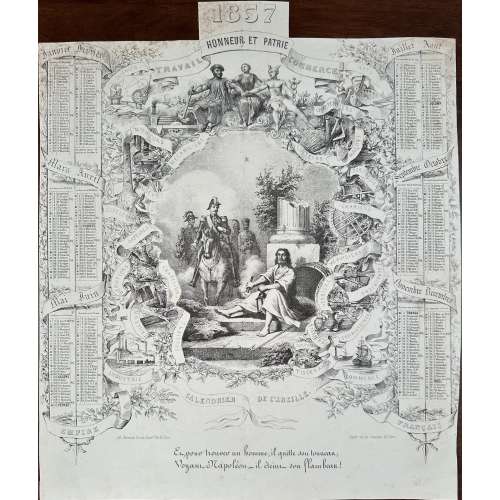 Lithography and etching on wove paper432 x 362 mm, black ink stamp “5022” to reverse, horizontal and vertical centrefolds. Depicts Diogenes (Ancient Greek, 412/404 – 323 BC) beside his barrel and extinguishing his torch when approached by Napoléon III ahorseback. Top: "1857 | HONNEUR ET PATRIE"; lettering on ribbons (top-down): SCIENCES, TRAVAIL, COMMERCE, ARTS, CHARPENTIERS, IMPRIMEURS, "MECHANICIENS, AGRICULTEURS, MAÇONS, FONDEURS, TERRASIERS, CIZELEURS, CARRIERS, ORFEVRES, BIJOUTIERS, CHAPELIERS, MENUISIERS, VERRIERS, SERRURIERS, TAILLEURS, SELLIERS, POTIERS, PORCELAINIERS, CORDONNIERS, TISSERANDS, INDUSTRIE, COMMERCE | CALENDRIER DE L'ABEILLE | EMPIRE, FRANÇAIS. Below left: "lith. Barousse Cour du Comm. 11 et 12. Paris"; right: "Dépôt rue des Cannettes, 20. Paris"; bottom: "Et, pour trouver un homme, il quitte son tonneau, | Voyant Napoléon, – il éteint son flambeau!" [And, to find a man, he leaves his barrel, | Seeing Napoleon, – he extinguishes his torch!]. Six months on the left and six months on the right-hand side of the calendar, surrounding the image.
Lithography and etching on wove paper432 x 362 mm, black ink stamp “5022” to reverse, horizontal and vertical centrefolds. Depicts Diogenes (Ancient Greek, 412/404 – 323 BC) beside his barrel and extinguishing his torch when approached by Napoléon III ahorseback. Top: "1857 | HONNEUR ET PATRIE"; lettering on ribbons (top-down): SCIENCES, TRAVAIL, COMMERCE, ARTS, CHARPENTIERS, IMPRIMEURS, "MECHANICIENS, AGRICULTEURS, MAÇONS, FONDEURS, TERRASIERS, CIZELEURS, CARRIERS, ORFEVRES, BIJOUTIERS, CHAPELIERS, MENUISIERS, VERRIERS, SERRURIERS, TAILLEURS, SELLIERS, POTIERS, PORCELAINIERS, CORDONNIERS, TISSERANDS, INDUSTRIE, COMMERCE | CALENDRIER DE L'ABEILLE | EMPIRE, FRANÇAIS. Below left: "lith. Barousse Cour du Comm. 11 et 12. Paris"; right: "Dépôt rue des Cannettes, 20. Paris"; bottom: "Et, pour trouver un homme, il quitte son tonneau, | Voyant Napoléon, – il éteint son flambeau!" [And, to find a man, he leaves his barrel, | Seeing Napoleon, – he extinguishes his torch!]. Six months on the left and six months on the right-hand side of the calendar, surrounding the image. -
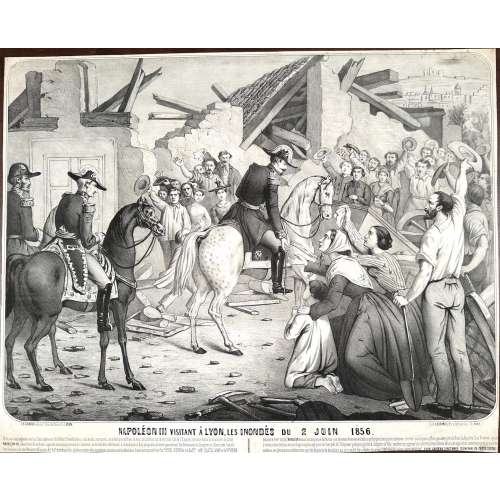 Lithography poster on wove paper, 492 x 614 mm; black ink stamp “5036” to reverse, vertical centerfold. Image in frame; under the frame left: "J. B. Gadola, éditeur. Cours de Brosses 1, à LYON."; right: "Lith LAURANT & Cie r. de Bernardins 34, Paris." Title and text below the image. Jean-Baptiste Gadola (French, 1818 – 1870) – publisher.
Lithography poster on wove paper, 492 x 614 mm; black ink stamp “5036” to reverse, vertical centerfold. Image in frame; under the frame left: "J. B. Gadola, éditeur. Cours de Brosses 1, à LYON."; right: "Lith LAURANT & Cie r. de Bernardins 34, Paris." Title and text below the image. Jean-Baptiste Gadola (French, 1818 – 1870) – publisher. -
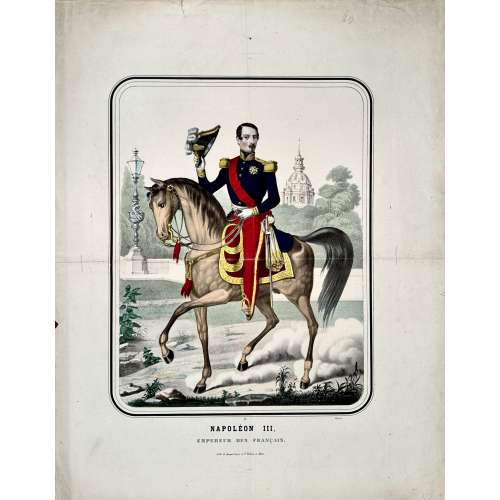 Hand-coloured chromolithography on wove paper, 600 x 470 mm; black ink stamp “4921” to reverse, horizontal and vertical centrefolds. Image of Napoléon III on horseback, in a frame; lettering under the frame: 34 — Déposé | NAPOLÉON III | EMPEREUR DES FRANÇAIS. | Lith. de Gangel frères et P. Didion, à Metz. || Gangel frères et P. Didion (Metz) – printer/publisher. Paulin Didion (French, 1831 – 1879)
Hand-coloured chromolithography on wove paper, 600 x 470 mm; black ink stamp “4921” to reverse, horizontal and vertical centrefolds. Image of Napoléon III on horseback, in a frame; lettering under the frame: 34 — Déposé | NAPOLÉON III | EMPEREUR DES FRANÇAIS. | Lith. de Gangel frères et P. Didion, à Metz. || Gangel frères et P. Didion (Metz) – printer/publisher. Paulin Didion (French, 1831 – 1879) -
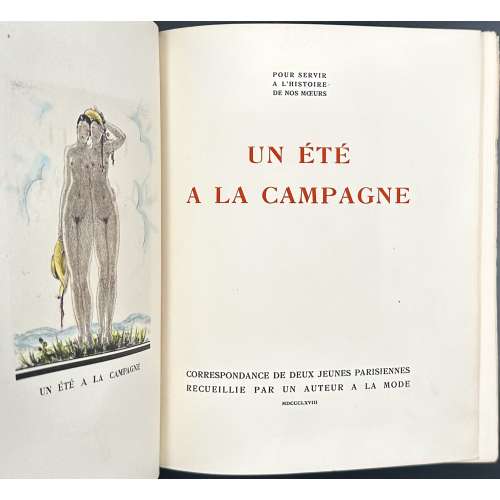 Softcover, 228 x 180 mm, tan French flapped wrappers with red lettering to front[1-4, owner’s glassine dustcover, top edge trimmed, printed on thick wove paper without a watermark; pp.: ffl [1-4 h.t., t.p.] 5-154 [2 blanks] colophon to back ffl recto, plus 12 plates with hand-coloured lithographs, extraneous to collation. Pencil and pigment drawing to h.t. signed “J. D’A” with gift manual inscription “A Monsieur et Madame Chalamel [sic] ce tardif mais sincère souvenir de sympathie”, signed “J et Y D’A.” Etching bookplate to front ffl recto: “EX LIBRIS PIERRE CHALLAMEL | JE FONCE DANS LE BROUILLARD”, signed “J A M” (Jean-Adrien Mercier). The signature J. D’A stands for Jean d’Angers, while Y D’A stands for Jean-Adrien’s wife Yvonne (1902—1999), nicknamed Zizi; they married in 1927. According to J.-P. Dutel, the stated illustrator of this edition, Jean d’Angers is indeed Jean-Adrien Mercier. The text belongs to Gustav Droz and, possibly, Auguste Poulet-Malassis. Limitation: the book was printed for subscribers in 30 copies on Japon Impériale paper (№№ 1-30) and 250 copies on vélin du Marais paper (№№ 31-280). This copy bears № 123 and was presented as a gift by the artist and his wife to Pierre Challamel. Title-page (red and black): POUR SERVIR | A L'HISTOIRE | DE NOS MŒURS | UN ÉTÉ | A LA CAMPAGNE | CORRESPONDANCE DE DEUX JEUNES PARISIENNES | RECUEILLIE PAR UN AUTEUR A LA MODE | MDCCCLXVIII || Catalogue raisonné: Dutel III № 2546; honesterotica. Provenance: Pierre Challamel (French, 20th century) Contributors: Gustave Droz (French, 1832 – 1895) – author (presumable). Auguste Poulet-Malassis (French, 1825 – 1878) – author (presumable). Jean-Adrien Mercier (French, 1899 – 1995) – artist. Micro photo of the lithography:
Softcover, 228 x 180 mm, tan French flapped wrappers with red lettering to front[1-4, owner’s glassine dustcover, top edge trimmed, printed on thick wove paper without a watermark; pp.: ffl [1-4 h.t., t.p.] 5-154 [2 blanks] colophon to back ffl recto, plus 12 plates with hand-coloured lithographs, extraneous to collation. Pencil and pigment drawing to h.t. signed “J. D’A” with gift manual inscription “A Monsieur et Madame Chalamel [sic] ce tardif mais sincère souvenir de sympathie”, signed “J et Y D’A.” Etching bookplate to front ffl recto: “EX LIBRIS PIERRE CHALLAMEL | JE FONCE DANS LE BROUILLARD”, signed “J A M” (Jean-Adrien Mercier). The signature J. D’A stands for Jean d’Angers, while Y D’A stands for Jean-Adrien’s wife Yvonne (1902—1999), nicknamed Zizi; they married in 1927. According to J.-P. Dutel, the stated illustrator of this edition, Jean d’Angers is indeed Jean-Adrien Mercier. The text belongs to Gustav Droz and, possibly, Auguste Poulet-Malassis. Limitation: the book was printed for subscribers in 30 copies on Japon Impériale paper (№№ 1-30) and 250 copies on vélin du Marais paper (№№ 31-280). This copy bears № 123 and was presented as a gift by the artist and his wife to Pierre Challamel. Title-page (red and black): POUR SERVIR | A L'HISTOIRE | DE NOS MŒURS | UN ÉTÉ | A LA CAMPAGNE | CORRESPONDANCE DE DEUX JEUNES PARISIENNES | RECUEILLIE PAR UN AUTEUR A LA MODE | MDCCCLXVIII || Catalogue raisonné: Dutel III № 2546; honesterotica. Provenance: Pierre Challamel (French, 20th century) Contributors: Gustave Droz (French, 1832 – 1895) – author (presumable). Auguste Poulet-Malassis (French, 1825 – 1878) – author (presumable). Jean-Adrien Mercier (French, 1899 – 1995) – artist. Micro photo of the lithography:
Micro photo of the original drawing: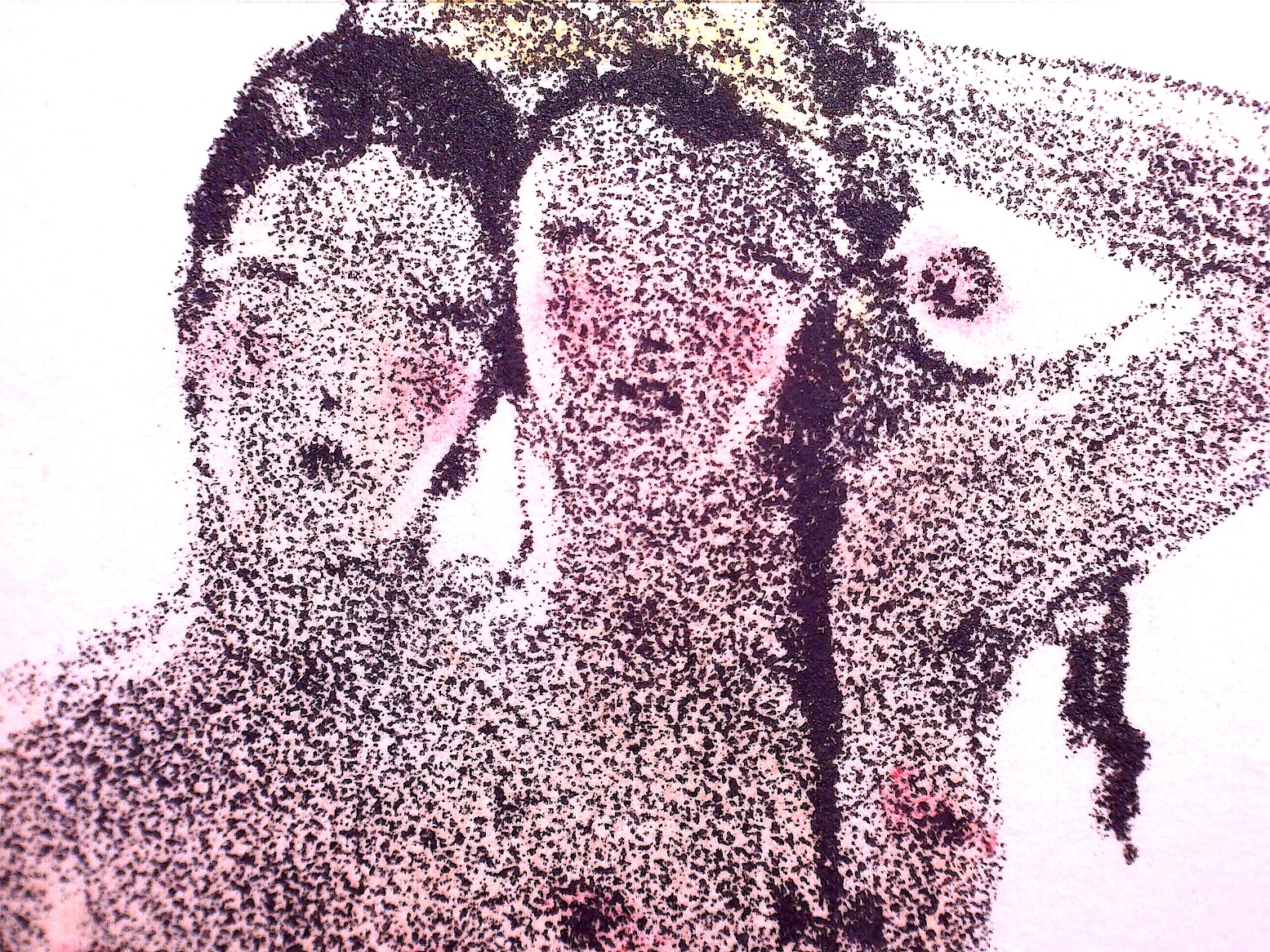
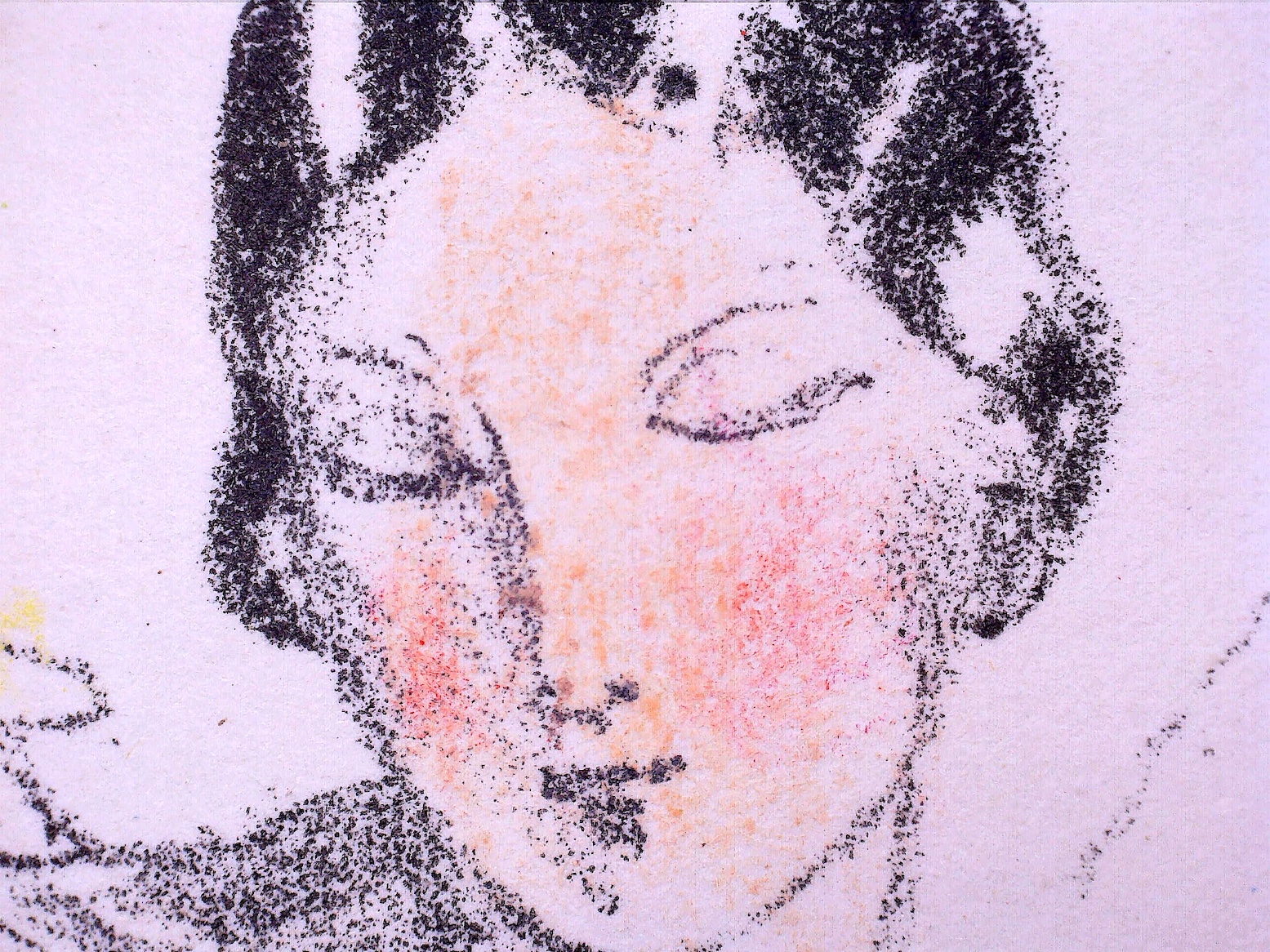
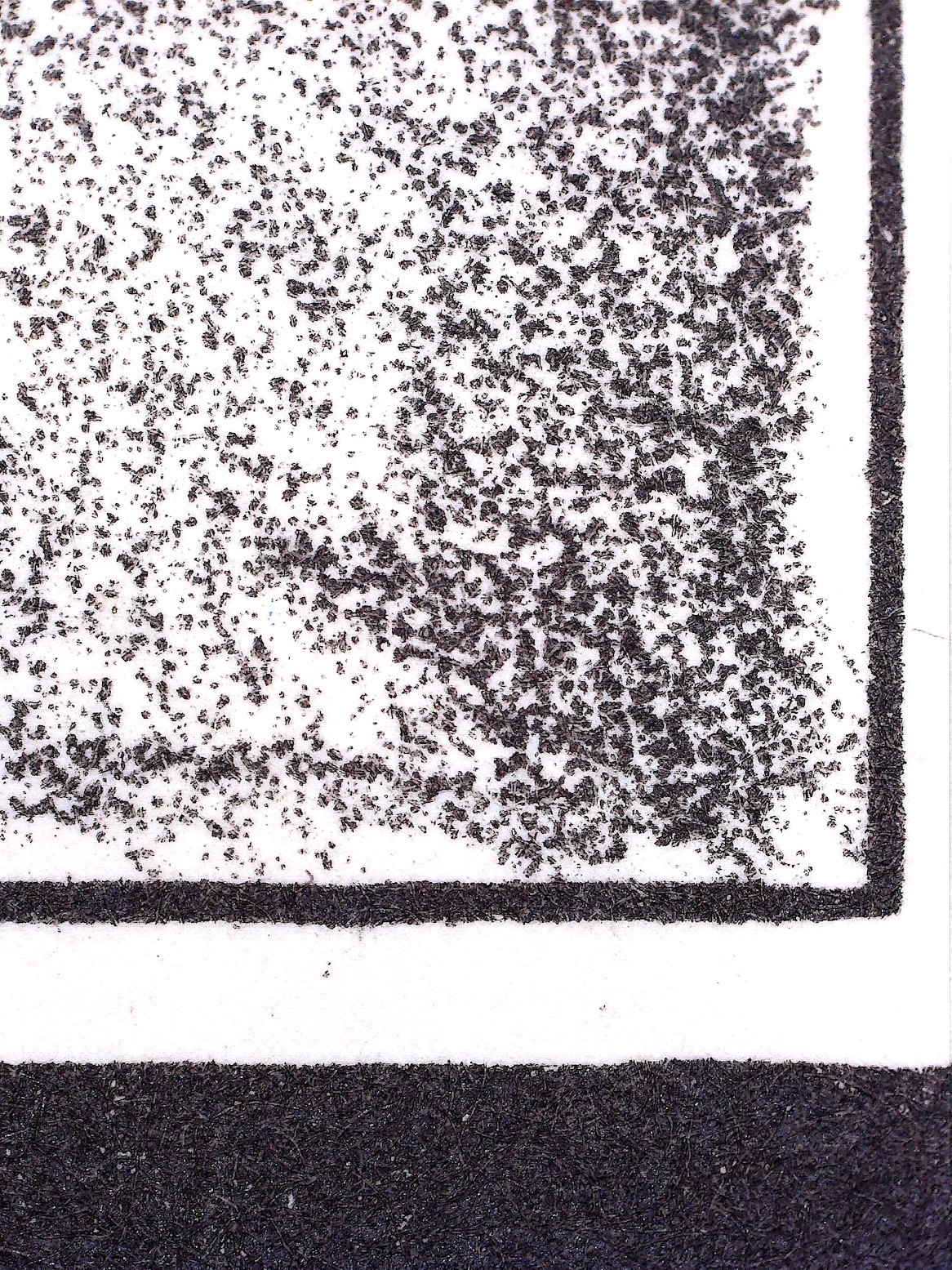
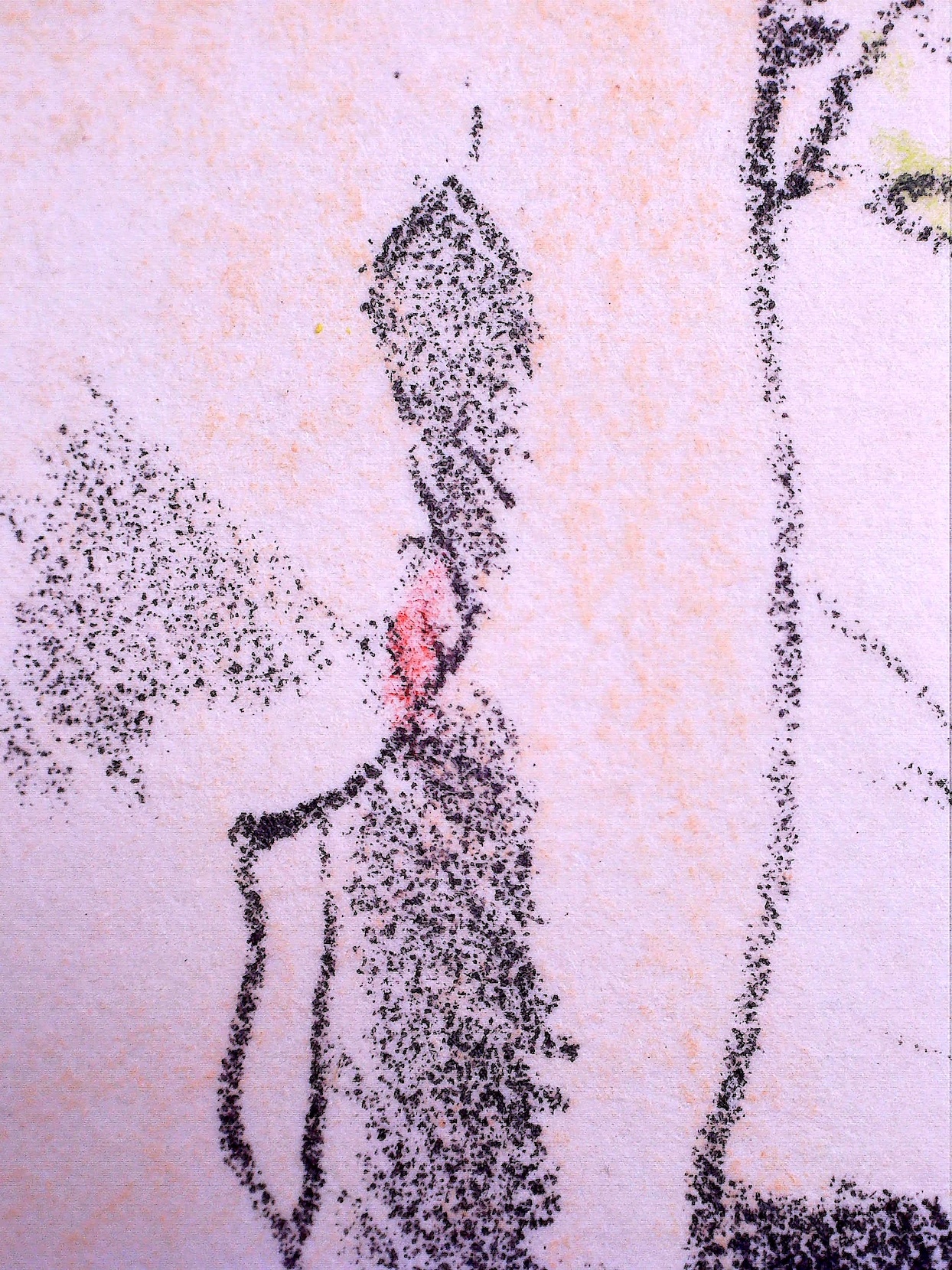
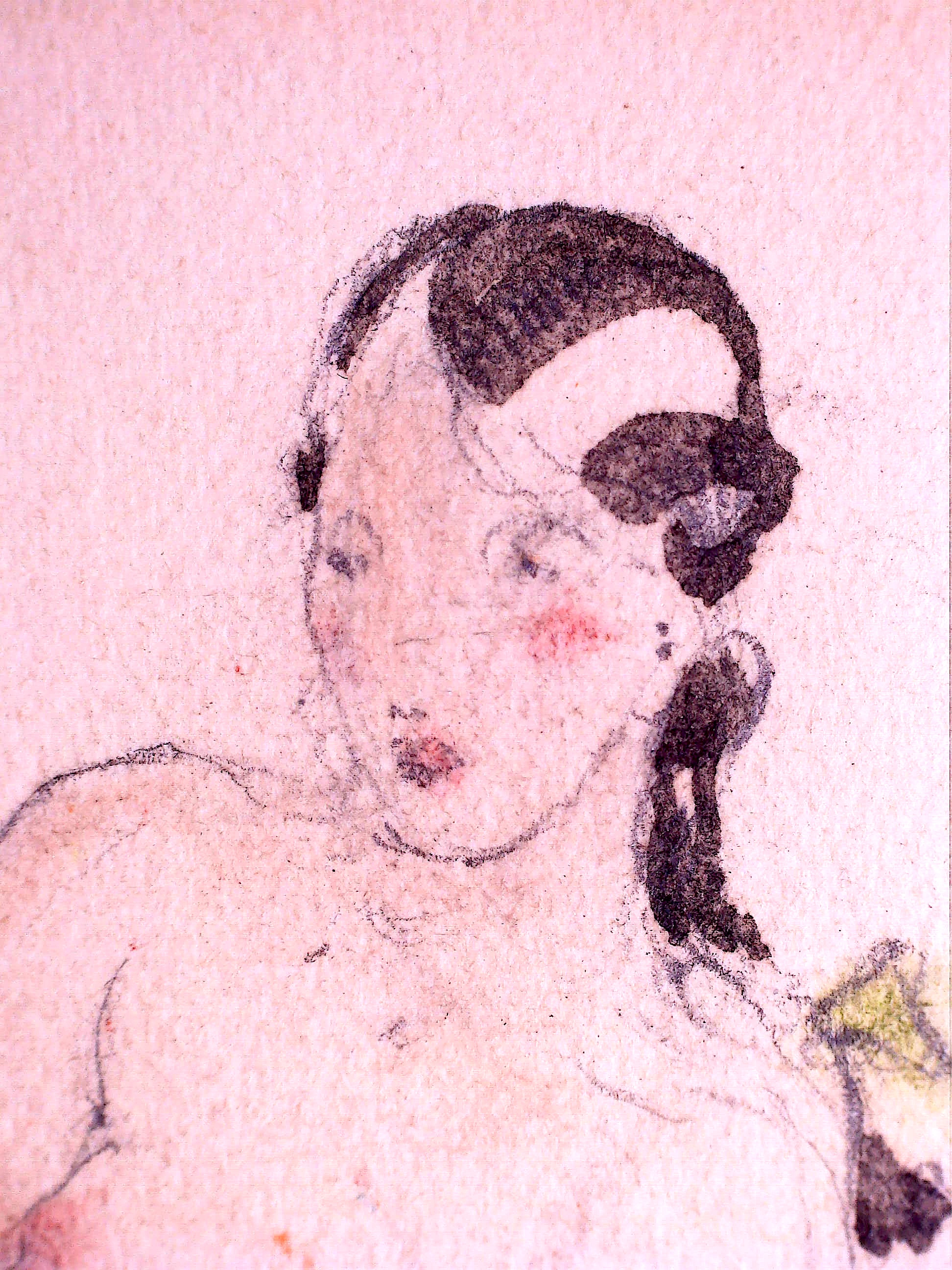
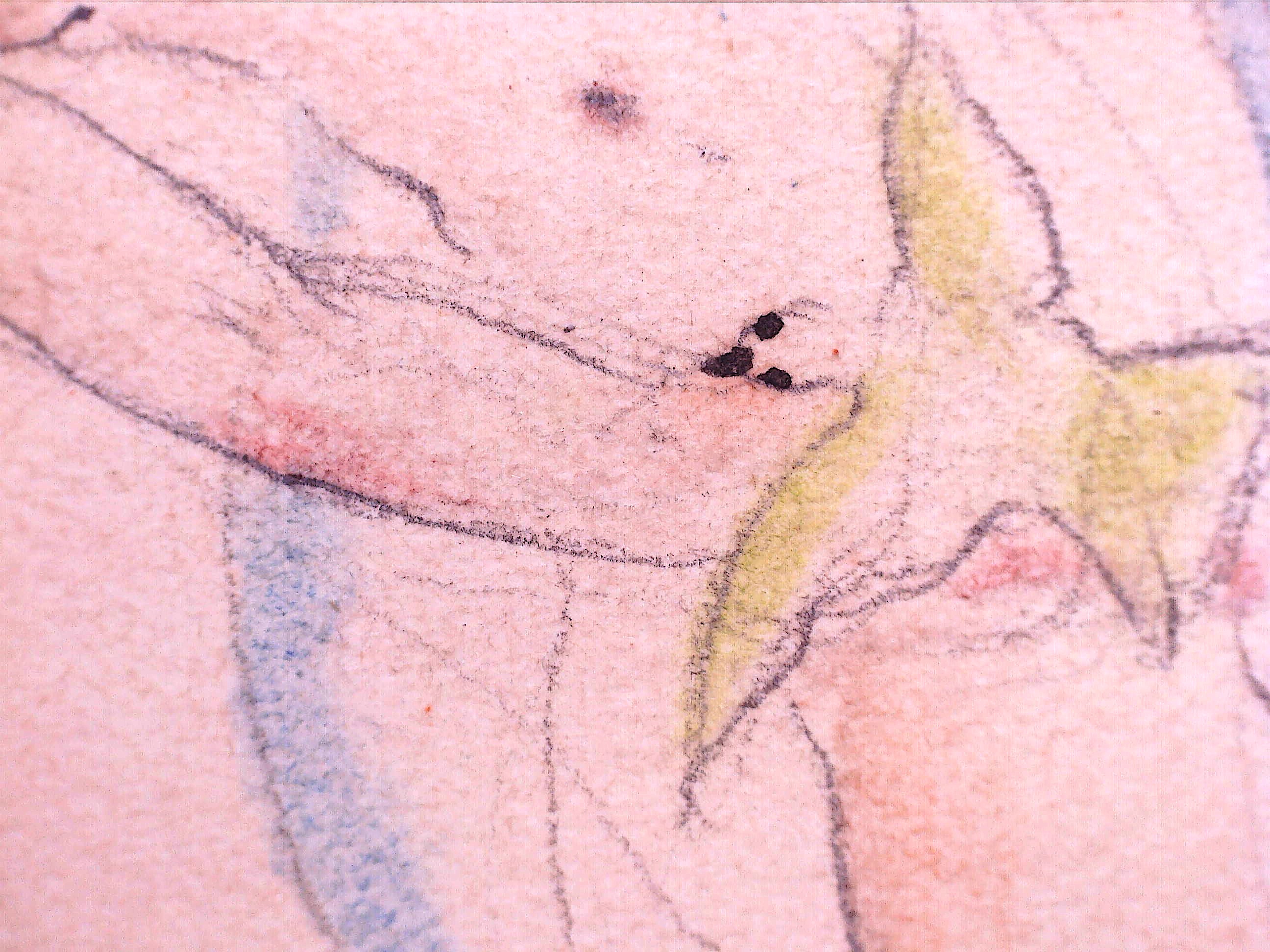
-
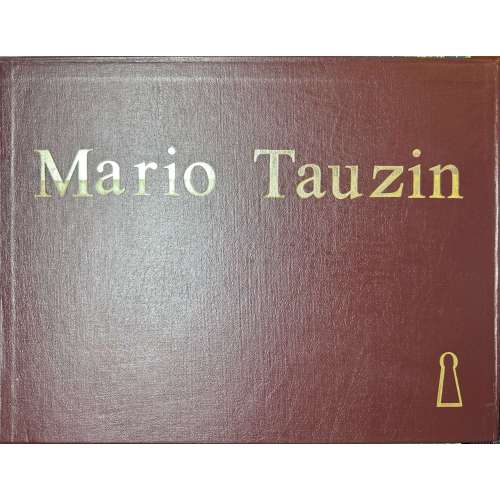 Set of 30 lithographic plates printed on watermarked Van Gelder Simili Japon wove paper, loose in two rexine-backed stiff paper wrappers, 15 in each, together in rexine portfolio with gilt lettering and keyhole on front cover. According to the seller, these are facsimiles of prints/ drawings by Mario Tauzin. Scenes from the series 'Interdit aux adultes'. No publisher indicated; printed in about 1950—a limited edition. Six of these designs used to illustrate 'Bonne à tout faire' were published by Éric Losfeld in the late 1950s (LIB-3293.2024). Dimensions: sheet 320 x 420 mm; album 330 x 430 mm. Contributor: Mario Tauzin (French, 1909 – 1979) — artist
Set of 30 lithographic plates printed on watermarked Van Gelder Simili Japon wove paper, loose in two rexine-backed stiff paper wrappers, 15 in each, together in rexine portfolio with gilt lettering and keyhole on front cover. According to the seller, these are facsimiles of prints/ drawings by Mario Tauzin. Scenes from the series 'Interdit aux adultes'. No publisher indicated; printed in about 1950—a limited edition. Six of these designs used to illustrate 'Bonne à tout faire' were published by Éric Losfeld in the late 1950s (LIB-3293.2024). Dimensions: sheet 320 x 420 mm; album 330 x 430 mm. Contributor: Mario Tauzin (French, 1909 – 1979) — artist -
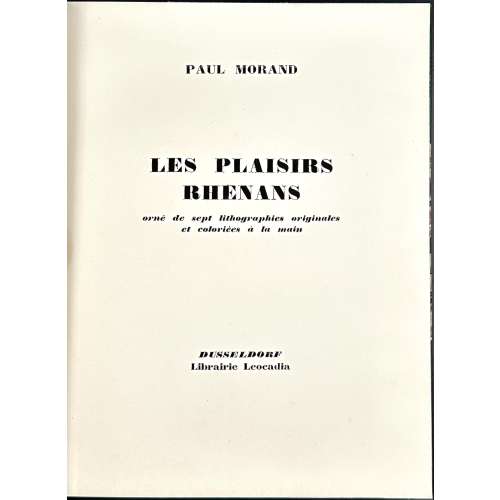 NEWHardcover, 255 x 200 mm, ¾ green morocco over marbled boards, gilt lettering to spine with raised bands, grey laid paper endpapers, Serge Golifman’s bookplate pasted to verso, 3 ffl, orig. wrappers, incl spine, preserved; collated: 2 blanks, h.t., t.p., 14 leaves of text; faux t.p. Éloge de la marquise de Beausemblant, 6 leaves of text, colophon (limitation), 2 blanks, 3 ffl, unpaginated, plus 7 leaves of plates, incl. frontispiece. Publisher's wrappers 250 x 190 mm. Title-page (red and black): PAUL MORAND | LES PLAISIRS | RHENANS | orné de sept lithographies originales | et coloriées à la main | DUSSELDORF | Librairie Leocadia || The front wrapper is the same, in black only. Limitation: Cette édition, imprimée pour une Société de Bibliophiles, a été tirée à 107 exemplaires hors commerce, savoir: exemplaires sur vieux japon, numérotés de 1 à 7, et 100 exemplaires sur vélin d'Arches, numérotés de 8 à 107. Les lithographies ont été tirées sur presse à bras et coloriées à la main. Les pierres ont été poncées après tirage. Exemplaire N° 81. [The edition was printed for a bibliophile society in 107 non-commercial copies: 7 copies on “vieux Japon” paper, numbered from 1 to 7, and 100 copies on “Arches Vellum”, numbered from 8 to 107, of which this is copy № 81]. An unauthorized (pirated) edition of two short stories by Paul Morand, initially published in “L’Europe galante” by Éditions Grasset in 1925: Les plaisirs rhénans and Éloge de la marquise de Beausemblant; illustrated with 7 lithographs coloured with crayons after Gaston-Louis Roux, printed by Mme Duchatel; the stones were then destroyed (sanded). According to Pia: « Pour le principe, semble-t-il, Bernard Grasset à qui aucune autorisation d’éditer ainsi ces deux nouvelles n'avait été demandée, déposa une plainte contre X... en contrefaçon. L'enquête judiciaire, si enquête il y eut, n’aboutit pas. Le tirage de l’édition « pirate » avait été si restreint que tous les exemplaires en avaient été vendus sitôt parus. Le coupable, en l’occurrence René Bonnel, ne fut pas inquiété ». Dutel attests: « Un des personnages, subissant une agréable fellation, représenté sur l'une des lithographies, ressemble fort à Paul Morand qui en avait pris ombrage! » Comment by the seller: L’ouvrage est d’autant plus rare que Morand lui-même, mécontent d’une des gravures qui le représente en position intéressante, fit détruire une partie des exemplaires. Resume: While Bernard Grasset opposed the pirated edition on copyright infringement grounds, Paul Morand was enraged by his resemblance to the depicted character; the latter destroyed as many copies of the edition as he could, so only a few still exist. The print run of the "pirate" edition was so limited that all the copies were sold as soon as they were published. Catalogue Raisonné: Dutel III № 2215 (p. 321) ; Pia : № 1056; Nordmann (I) № 281. Contributors: Paul Morand (French, 1888 – 1976) – author Gaston-Louis Roux (French, 1904 – 1988) – artist René Bonnel (French, 18841 – 1975) – publisher Bernard Grasset (French, 1881 – 1955) – publisher
NEWHardcover, 255 x 200 mm, ¾ green morocco over marbled boards, gilt lettering to spine with raised bands, grey laid paper endpapers, Serge Golifman’s bookplate pasted to verso, 3 ffl, orig. wrappers, incl spine, preserved; collated: 2 blanks, h.t., t.p., 14 leaves of text; faux t.p. Éloge de la marquise de Beausemblant, 6 leaves of text, colophon (limitation), 2 blanks, 3 ffl, unpaginated, plus 7 leaves of plates, incl. frontispiece. Publisher's wrappers 250 x 190 mm. Title-page (red and black): PAUL MORAND | LES PLAISIRS | RHENANS | orné de sept lithographies originales | et coloriées à la main | DUSSELDORF | Librairie Leocadia || The front wrapper is the same, in black only. Limitation: Cette édition, imprimée pour une Société de Bibliophiles, a été tirée à 107 exemplaires hors commerce, savoir: exemplaires sur vieux japon, numérotés de 1 à 7, et 100 exemplaires sur vélin d'Arches, numérotés de 8 à 107. Les lithographies ont été tirées sur presse à bras et coloriées à la main. Les pierres ont été poncées après tirage. Exemplaire N° 81. [The edition was printed for a bibliophile society in 107 non-commercial copies: 7 copies on “vieux Japon” paper, numbered from 1 to 7, and 100 copies on “Arches Vellum”, numbered from 8 to 107, of which this is copy № 81]. An unauthorized (pirated) edition of two short stories by Paul Morand, initially published in “L’Europe galante” by Éditions Grasset in 1925: Les plaisirs rhénans and Éloge de la marquise de Beausemblant; illustrated with 7 lithographs coloured with crayons after Gaston-Louis Roux, printed by Mme Duchatel; the stones were then destroyed (sanded). According to Pia: « Pour le principe, semble-t-il, Bernard Grasset à qui aucune autorisation d’éditer ainsi ces deux nouvelles n'avait été demandée, déposa une plainte contre X... en contrefaçon. L'enquête judiciaire, si enquête il y eut, n’aboutit pas. Le tirage de l’édition « pirate » avait été si restreint que tous les exemplaires en avaient été vendus sitôt parus. Le coupable, en l’occurrence René Bonnel, ne fut pas inquiété ». Dutel attests: « Un des personnages, subissant une agréable fellation, représenté sur l'une des lithographies, ressemble fort à Paul Morand qui en avait pris ombrage! » Comment by the seller: L’ouvrage est d’autant plus rare que Morand lui-même, mécontent d’une des gravures qui le représente en position intéressante, fit détruire une partie des exemplaires. Resume: While Bernard Grasset opposed the pirated edition on copyright infringement grounds, Paul Morand was enraged by his resemblance to the depicted character; the latter destroyed as many copies of the edition as he could, so only a few still exist. The print run of the "pirate" edition was so limited that all the copies were sold as soon as they were published. Catalogue Raisonné: Dutel III № 2215 (p. 321) ; Pia : № 1056; Nordmann (I) № 281. Contributors: Paul Morand (French, 1888 – 1976) – author Gaston-Louis Roux (French, 1904 – 1988) – artist René Bonnel (French, 18841 – 1975) – publisher Bernard Grasset (French, 1881 – 1955) – publisher -
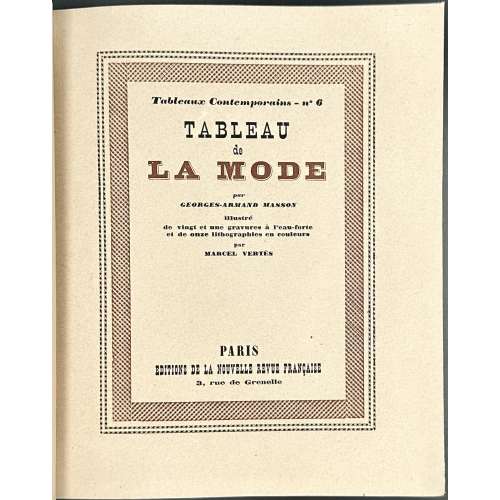 NEWHardcover, 244 x 205 mm, red quarter morocco over marbled boards, gilt lettering and raised bands to spine, marbled endpapers, original wrappers 235 x 190 mm preserved. Collated 4to: 3 ffl, front wrapper2, blank4, h.t./imprint6, frontis.8, t.p.10, 1-234, blank196, back wrapper198, 3ffl; pp.: [1-11] 12-186 [12], plates and wrappers within collation. Total number of leaves from wrapper to wrapper 198 (190 per Vokaer). Title-page (brown and black): Tableaux Contemporains – no 6 | TABLEAU | de | LA MODE | par | GEORGES-ARMAND MASSON | illustré | de vingt et une gravures à l'eau-forte | et de onze lithographies en couleurs | par | MARCEL VERTÈS | PARIS | ÉDITIONS DE LA NOUVELLE REVUE FRANÇAISE | 3, rue de Grenelle || Front wrapper: same as t.p., framed. Back wrapper: advert. dans la même collection, framed. Imprint: Un exemplaire sur japon impérial (A), 6 exemplaires sur japon impérial (B-E), 15 exemplaires sur japon impérial (F-T), 320 exemplaires sur vélin pur fil Lafuma-Navarre (dont 20 exemplaires hors commerce), numérotés de 1 a 300 et de I a XX. Exemplaire no 238. Tous droits de reproduction el de traduction réserves pour tous les pays, y compris la Russie. Copyright by Librairie Gallimard, 1926. Colophon: CE VOLUME, | LE SIXIEME DE LA COLLECTION DES | TABLEAUX CONTEMPORAINS, | A ÉTE ACHEVE D’IMPRIMER | LE DIX MAI MIL NEUF CENT VINGT-SIX : | POUR LE TEXTE, | PAR LE MAITRE IMPRIMEUR COULOUMA, A ARGENTEUIL, | H. BARTHELEMY ETANT DIRECTEUR, | ET POUR LES GRAVURES, | PAR CLOT, LITHOGRAPHE | ET HAASEN, IMPRIMEUR EN TAILLE-DOUCE | A PARIS || Limited Edition: 22 copies printed on Japon Impérial paper marked letters A to T enriched with suites of plates and original drawings; 20 copies marked I to XX on Vélin pur fil Lafuma-Navarre paper not for sale, and 300 commercial copies on the same paper, numbered 1 to 300, of which this is copy № 238. Total number of copies 342. Catalogue Raisonné: Vokaer № 14, p. 10. Contributors: Masson, Georges-Armand (French, 1892 – 1977) – author Marcel Vertès [Marcell Vértes] (Jewish-Hungarian-French, 1895 – 1961) – artist Clot, Auguste (French, 1858 – 1936) – lithography Haasen, Paul (French, d. 1944) – etchings
NEWHardcover, 244 x 205 mm, red quarter morocco over marbled boards, gilt lettering and raised bands to spine, marbled endpapers, original wrappers 235 x 190 mm preserved. Collated 4to: 3 ffl, front wrapper2, blank4, h.t./imprint6, frontis.8, t.p.10, 1-234, blank196, back wrapper198, 3ffl; pp.: [1-11] 12-186 [12], plates and wrappers within collation. Total number of leaves from wrapper to wrapper 198 (190 per Vokaer). Title-page (brown and black): Tableaux Contemporains – no 6 | TABLEAU | de | LA MODE | par | GEORGES-ARMAND MASSON | illustré | de vingt et une gravures à l'eau-forte | et de onze lithographies en couleurs | par | MARCEL VERTÈS | PARIS | ÉDITIONS DE LA NOUVELLE REVUE FRANÇAISE | 3, rue de Grenelle || Front wrapper: same as t.p., framed. Back wrapper: advert. dans la même collection, framed. Imprint: Un exemplaire sur japon impérial (A), 6 exemplaires sur japon impérial (B-E), 15 exemplaires sur japon impérial (F-T), 320 exemplaires sur vélin pur fil Lafuma-Navarre (dont 20 exemplaires hors commerce), numérotés de 1 a 300 et de I a XX. Exemplaire no 238. Tous droits de reproduction el de traduction réserves pour tous les pays, y compris la Russie. Copyright by Librairie Gallimard, 1926. Colophon: CE VOLUME, | LE SIXIEME DE LA COLLECTION DES | TABLEAUX CONTEMPORAINS, | A ÉTE ACHEVE D’IMPRIMER | LE DIX MAI MIL NEUF CENT VINGT-SIX : | POUR LE TEXTE, | PAR LE MAITRE IMPRIMEUR COULOUMA, A ARGENTEUIL, | H. BARTHELEMY ETANT DIRECTEUR, | ET POUR LES GRAVURES, | PAR CLOT, LITHOGRAPHE | ET HAASEN, IMPRIMEUR EN TAILLE-DOUCE | A PARIS || Limited Edition: 22 copies printed on Japon Impérial paper marked letters A to T enriched with suites of plates and original drawings; 20 copies marked I to XX on Vélin pur fil Lafuma-Navarre paper not for sale, and 300 commercial copies on the same paper, numbered 1 to 300, of which this is copy № 238. Total number of copies 342. Catalogue Raisonné: Vokaer № 14, p. 10. Contributors: Masson, Georges-Armand (French, 1892 – 1977) – author Marcel Vertès [Marcell Vértes] (Jewish-Hungarian-French, 1895 – 1961) – artist Clot, Auguste (French, 1858 – 1936) – lithography Haasen, Paul (French, d. 1944) – etchings -
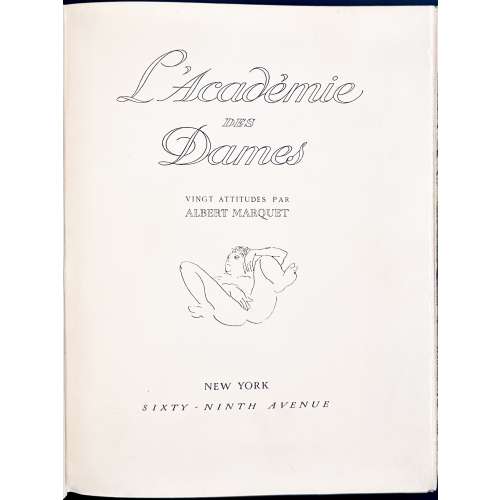 NEWHardcover, 330 x 255 mm, marble paper, two labels of black calf with gilt lettering to spine, 2 blank leaves at front and 2 at back (laid paper), two leaves of lithographic vignettes (t.p. and limitation), plus 20 lithographic plates signed “am”, unpaginated. Limited edition of 25 copies on Japon Impérial paper №№ 1-25, 300 copies on Vélin d’Arches №№ 26-325, of which this is copy № 206. Stones sanded. A poem by Verlaine at p. 2 recto. Title-page: L'Académie | DES | Dames | VINGT ATTITUDES PAR | ALBERT MARQUET | {vignette} | NEW YORK | SIXTY-NINTH AVENUE || Imprint: ÉDITION PRIVÉE | EXEMPLAIRE NUMERO 206 Limitation: JUSTIFICATION DU TIRAGE | IL A ÉTÉ TIRÉ DE CET OUVRAGE | VINGT-CINQ EXEMPLAIRES SUR JAPON IMPÉRIAL | NUMÉROTÉS DE 1 à 25 | ET TROIS CENTS EXEMPLAIRES SUR VÉLIN D'ARCHES | NUMÉROTÉS DE 26 à 325 | PIERRES BIFFÉES || Catalogue raisonné: Dutel III № 949; Nordmann I № 255. Provenance: From the collection of Hans-Jürgen Döpp, Frankfurt. Contributors: Albert Marquet (French, 1875 – 1947) Verlaine, Paul (French, 1844 – 1896) One additional lithographic plate by Marquet from a different source but on a similar subject is laid in.
NEWHardcover, 330 x 255 mm, marble paper, two labels of black calf with gilt lettering to spine, 2 blank leaves at front and 2 at back (laid paper), two leaves of lithographic vignettes (t.p. and limitation), plus 20 lithographic plates signed “am”, unpaginated. Limited edition of 25 copies on Japon Impérial paper №№ 1-25, 300 copies on Vélin d’Arches №№ 26-325, of which this is copy № 206. Stones sanded. A poem by Verlaine at p. 2 recto. Title-page: L'Académie | DES | Dames | VINGT ATTITUDES PAR | ALBERT MARQUET | {vignette} | NEW YORK | SIXTY-NINTH AVENUE || Imprint: ÉDITION PRIVÉE | EXEMPLAIRE NUMERO 206 Limitation: JUSTIFICATION DU TIRAGE | IL A ÉTÉ TIRÉ DE CET OUVRAGE | VINGT-CINQ EXEMPLAIRES SUR JAPON IMPÉRIAL | NUMÉROTÉS DE 1 à 25 | ET TROIS CENTS EXEMPLAIRES SUR VÉLIN D'ARCHES | NUMÉROTÉS DE 26 à 325 | PIERRES BIFFÉES || Catalogue raisonné: Dutel III № 949; Nordmann I № 255. Provenance: From the collection of Hans-Jürgen Döpp, Frankfurt. Contributors: Albert Marquet (French, 1875 – 1947) Verlaine, Paul (French, 1844 – 1896) One additional lithographic plate by Marquet from a different source but on a similar subject is laid in.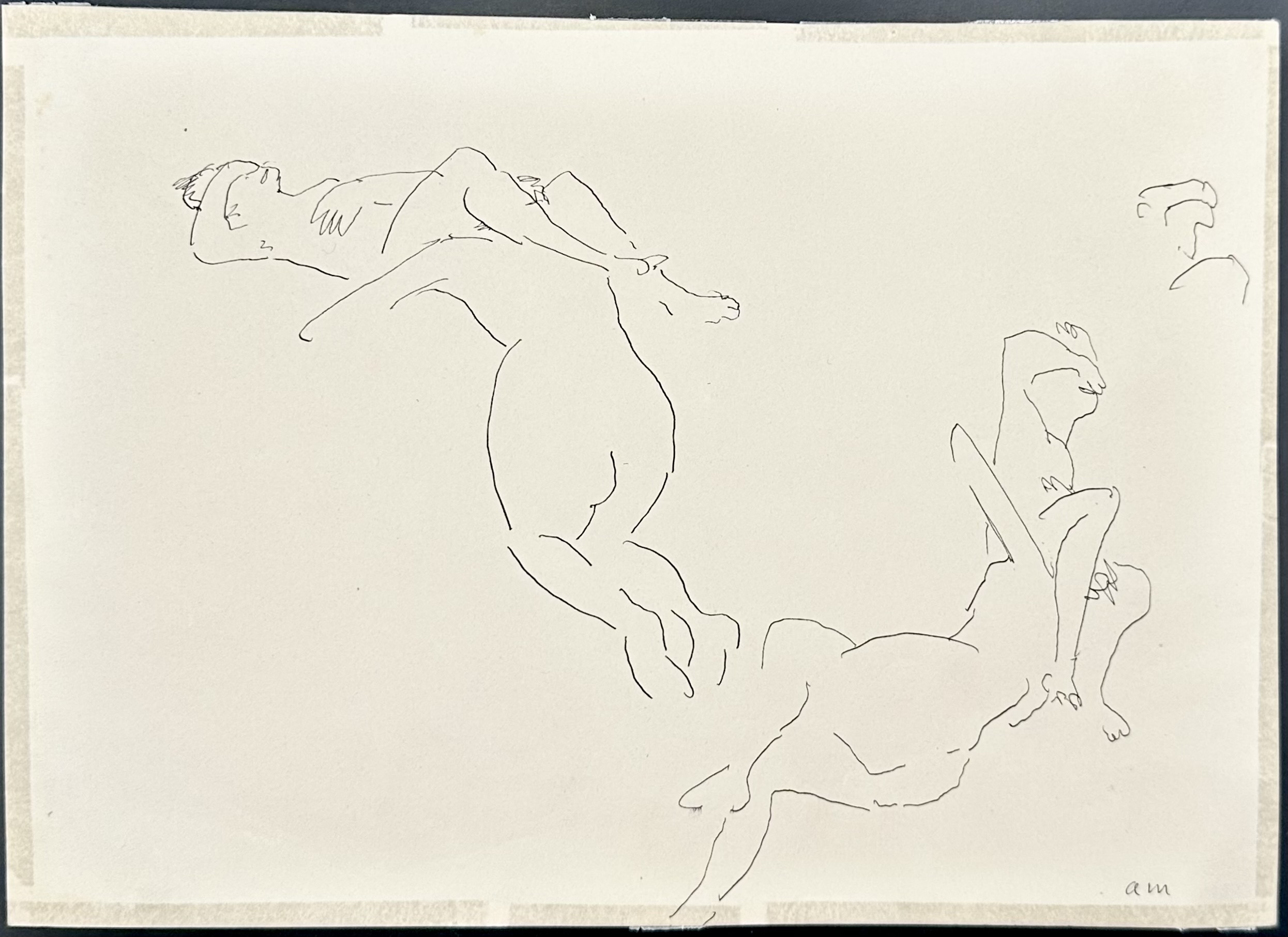
-
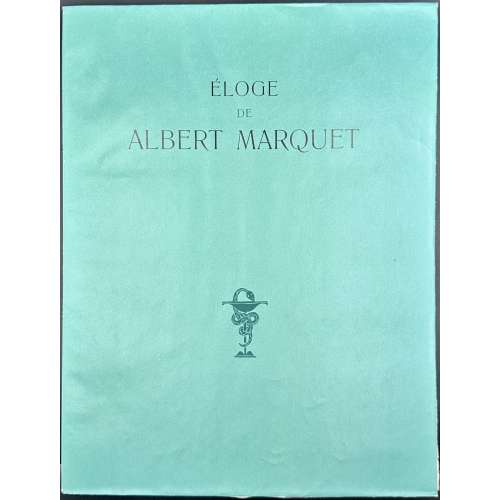 NEWSoftcover, 328 x 250 mm, green French flapped wrappers, lettered; 22 leaves plus 2 in wrappers, unpaginated, incl. frontispiece (etching), headpiece (lithography), 4 in-text illustrations (1 lithography + 3 etchings), and 5 plates (3 dry points + 1 etching = 1 lithography) by Albert Marquet. Limited edition of 200 copies on Arches Vellum, watermarked, of which this is copy № 144; published by Manuel Bruker on May 16, 1948; lithographs printed by André Clot. Title-page (olive and black): ÉLOGE | DE | ALBERT MARQUET | PAR | LÉON WERTH | ORNÉ | DE GRAVURES ORIGINALES | {publisher’s device} | MANUEL BRUKER ÉDITEUR || Colophon: J'AI ACHEVÉ D'IMPRIMER | CET OUVRAGE LE JOUR DE | LA PENTECOTE 1948 A 200 | EXEMPLAIRES SUR VÉLIN | D'ARCHES A LA FORME NU | MÉROTES DE 1 A 200. ON | A JOINT AUX 20 PREMIERS | EXEMPLAIRES UNE SUITE | SUR PAPIER JAPON ANCIEN | ET UNE SUITE DES PLAN | CHES NON UTILISEES. LES | LITHOGRAPHIES ONT ÉTÉ | TIRÉES PAR ANDRÉ CLOT. The day of Pentecost in 1948 was Sunday, May 16. Contributors: Werth, Léon (French, 1878 – 1955) – author Marquet, Albert (French, 1875 – 1947) – artist Bruker, Manuel [Mendel] (Jewish-Hungarian-French, 1891 – 1979) – publisher Clot, André (French, 1909 – 2002) – printer
NEWSoftcover, 328 x 250 mm, green French flapped wrappers, lettered; 22 leaves plus 2 in wrappers, unpaginated, incl. frontispiece (etching), headpiece (lithography), 4 in-text illustrations (1 lithography + 3 etchings), and 5 plates (3 dry points + 1 etching = 1 lithography) by Albert Marquet. Limited edition of 200 copies on Arches Vellum, watermarked, of which this is copy № 144; published by Manuel Bruker on May 16, 1948; lithographs printed by André Clot. Title-page (olive and black): ÉLOGE | DE | ALBERT MARQUET | PAR | LÉON WERTH | ORNÉ | DE GRAVURES ORIGINALES | {publisher’s device} | MANUEL BRUKER ÉDITEUR || Colophon: J'AI ACHEVÉ D'IMPRIMER | CET OUVRAGE LE JOUR DE | LA PENTECOTE 1948 A 200 | EXEMPLAIRES SUR VÉLIN | D'ARCHES A LA FORME NU | MÉROTES DE 1 A 200. ON | A JOINT AUX 20 PREMIERS | EXEMPLAIRES UNE SUITE | SUR PAPIER JAPON ANCIEN | ET UNE SUITE DES PLAN | CHES NON UTILISEES. LES | LITHOGRAPHIES ONT ÉTÉ | TIRÉES PAR ANDRÉ CLOT. The day of Pentecost in 1948 was Sunday, May 16. Contributors: Werth, Léon (French, 1878 – 1955) – author Marquet, Albert (French, 1875 – 1947) – artist Bruker, Manuel [Mendel] (Jewish-Hungarian-French, 1891 – 1979) – publisher Clot, André (French, 1909 – 2002) – printer -
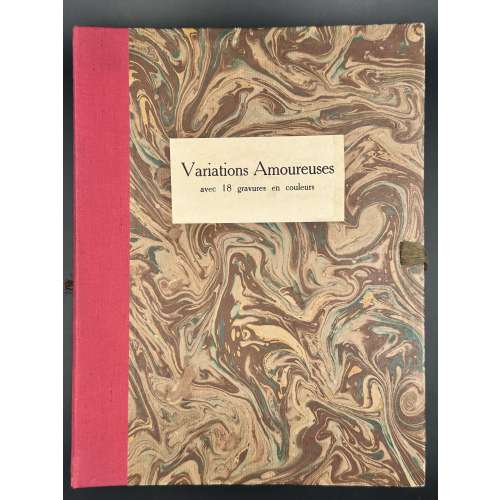 NEWA cardboard file 298 x 225 mm made of quarter red cloth over marbled paper, with laces, contains 18 loose chromolithographs approx.190 x 130 mm, 8 vertical and 10 horizontal) in a passepartout 275 x 220 mm (matted) of laid paper with an armorial watermark, with lewd humorous captions on glassine guard tissue attached to each sheet, upper and outer margins uncut. Images signed “–Santippa–36”.Label to front cover lettered Variations Amoureuses | avec 18 gravures en couleurs ||. No title page. It is quite likely that the set exists in only one copy. Description by seller: Album in-folio, 272 x 218 cm. En feuilles, sous chemise cartonnée à lacets de l'éditeur. Les lithographies sont respectivement intitulées : Branlade; Plaisir Champêtre; Justice; Entre Marins ; Cocher; Suce-moi bien ; Encore; Les Joies; Un Marin; On raconte ; Plaisir Divin ; Le Marin; Quand un Gendarme ; soixante et Neuf; Tous les Moyens ; Le Plus Cochon; Le Fantassin; Coup Double. Le peintre Gaston Hoffmann (1883-1977), consacra la majeure partie de son œuvre à l'érotisme et la caricature, en signant ses sujets trop libres sous le pseudonyme de Santippa. Contributor: Gaston Hoffmann [Santippa] (French, 1883 – 1977). Ref: Honesterotica.com provides only 8 images of 18. Catalogue raisonné: Dutel III: № 2581:
NEWA cardboard file 298 x 225 mm made of quarter red cloth over marbled paper, with laces, contains 18 loose chromolithographs approx.190 x 130 mm, 8 vertical and 10 horizontal) in a passepartout 275 x 220 mm (matted) of laid paper with an armorial watermark, with lewd humorous captions on glassine guard tissue attached to each sheet, upper and outer margins uncut. Images signed “–Santippa–36”.Label to front cover lettered Variations Amoureuses | avec 18 gravures en couleurs ||. No title page. It is quite likely that the set exists in only one copy. Description by seller: Album in-folio, 272 x 218 cm. En feuilles, sous chemise cartonnée à lacets de l'éditeur. Les lithographies sont respectivement intitulées : Branlade; Plaisir Champêtre; Justice; Entre Marins ; Cocher; Suce-moi bien ; Encore; Les Joies; Un Marin; On raconte ; Plaisir Divin ; Le Marin; Quand un Gendarme ; soixante et Neuf; Tous les Moyens ; Le Plus Cochon; Le Fantassin; Coup Double. Le peintre Gaston Hoffmann (1883-1977), consacra la majeure partie de son œuvre à l'érotisme et la caricature, en signant ses sujets trop libres sous le pseudonyme de Santippa. Contributor: Gaston Hoffmann [Santippa] (French, 1883 – 1977). Ref: Honesterotica.com provides only 8 images of 18. Catalogue raisonné: Dutel III: № 2581: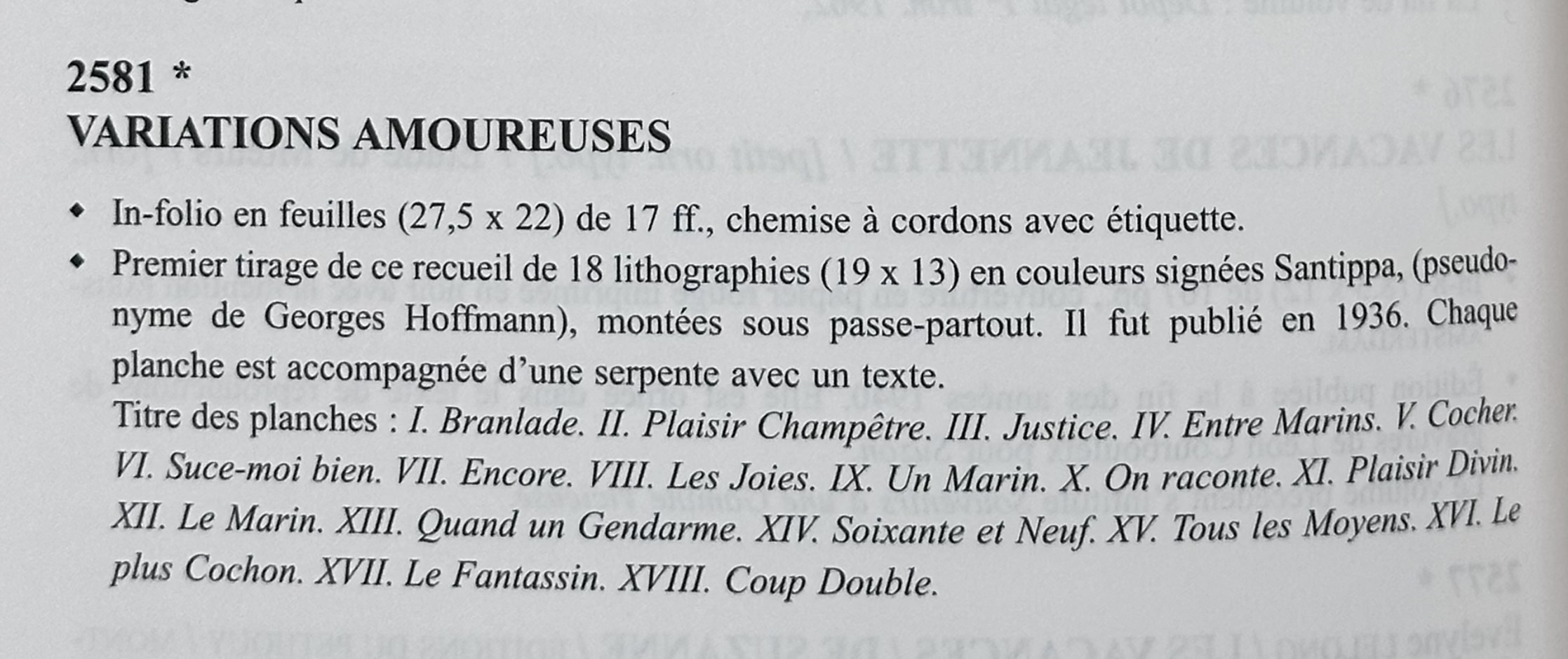
-
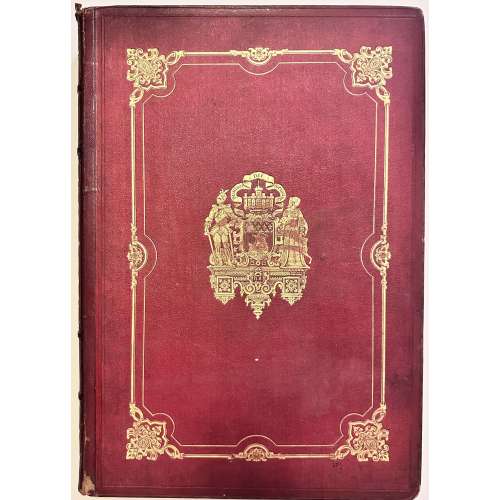 NEWThree volumes, hardcover in-folio, 495 x 350 mm, 1st edition, uniformly bound in red faux-chagrin with gilt coat of arms of the city of Paris in the centre of gild-decorated panel, gilt decorated spine with lettering, marbled endpapers, 3 vol. (122 p.-[46] pl., 76-44-24-22-36-26...); vol. 1 – 340 pp, vol. 2 – 296 pp, vol. 3 – 268 pp ; total 100 leaves of plates. Title-page (red and black): PARIS | DANS SA SPLENDEUR | MONUMENTS, VUES, SCÉNES HISTORIQUES, DESCRIPTIONS ET HISTOIRE | DESSINS ET LITHOGRAPHIES | […] | VIGNETTES DE FÉLIX BENOIST ET CATENACCI, EXÉCUTÉES SUR BOIS PAR LES PREMIERS GRAVURS | TEXTE | […] | Premier Volume (Deuxième Volume, Troisième Volume) | PREMIERE PARTIE. — DESCRIPTION DE PARIS | {vignette} | Publié par | HENRI CHARPENTIER, IMPRIMEUR-ÉDITEUR | PARIS, QUAI DES GRANDS-AUGUSTINS, 55. — ÉTABLESSEMENT A NANTES, RUE DE LA FOSSE. | M. DCCC. LXI. || Contributors: Mérimée, Prosper (French, 1803 – 1870) – text Viollet-le-Duc, Eugène (French, 1814 – 1879) – text Audiganne, Armand (French, 1814 – 1875) – text Philippe Benoist (French, 1813 – 1896) – lithography Benoist, Félix (French, 1818 – 1896) – woodcuts Catenacci, Hercule Louis (French, 1816 – 1884) – woodcuts Charpentier, Henri-Désiré (French, 1806 – 1882) Henri Charpentier imprimeur (Nantes) – printer Henri Charpentier éditeur (Paris) –publisher
NEWThree volumes, hardcover in-folio, 495 x 350 mm, 1st edition, uniformly bound in red faux-chagrin with gilt coat of arms of the city of Paris in the centre of gild-decorated panel, gilt decorated spine with lettering, marbled endpapers, 3 vol. (122 p.-[46] pl., 76-44-24-22-36-26...); vol. 1 – 340 pp, vol. 2 – 296 pp, vol. 3 – 268 pp ; total 100 leaves of plates. Title-page (red and black): PARIS | DANS SA SPLENDEUR | MONUMENTS, VUES, SCÉNES HISTORIQUES, DESCRIPTIONS ET HISTOIRE | DESSINS ET LITHOGRAPHIES | […] | VIGNETTES DE FÉLIX BENOIST ET CATENACCI, EXÉCUTÉES SUR BOIS PAR LES PREMIERS GRAVURS | TEXTE | […] | Premier Volume (Deuxième Volume, Troisième Volume) | PREMIERE PARTIE. — DESCRIPTION DE PARIS | {vignette} | Publié par | HENRI CHARPENTIER, IMPRIMEUR-ÉDITEUR | PARIS, QUAI DES GRANDS-AUGUSTINS, 55. — ÉTABLESSEMENT A NANTES, RUE DE LA FOSSE. | M. DCCC. LXI. || Contributors: Mérimée, Prosper (French, 1803 – 1870) – text Viollet-le-Duc, Eugène (French, 1814 – 1879) – text Audiganne, Armand (French, 1814 – 1875) – text Philippe Benoist (French, 1813 – 1896) – lithography Benoist, Félix (French, 1818 – 1896) – woodcuts Catenacci, Hercule Louis (French, 1816 – 1884) – woodcuts Charpentier, Henri-Désiré (French, 1806 – 1882) Henri Charpentier imprimeur (Nantes) – printer Henri Charpentier éditeur (Paris) –publisher


